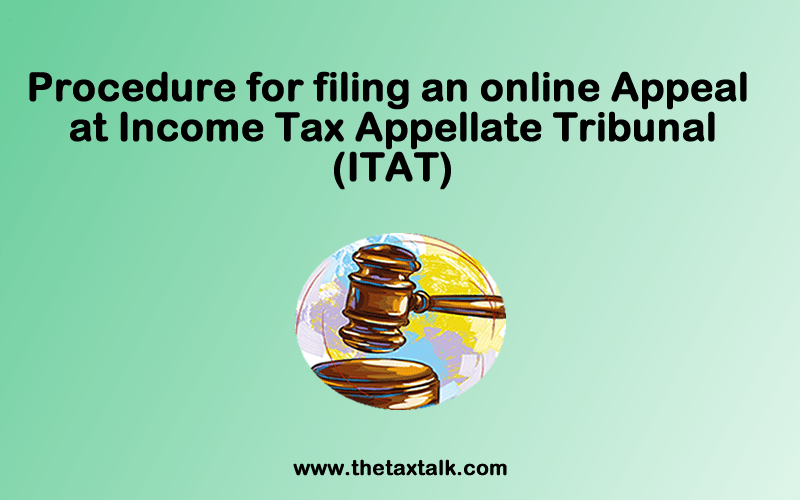![]()
Procedure for filing an online Appeal at Income Tax Appellate Tribunal (ITAT)
From manual filing, the procedure has not been changed to e-filing procedure.Let us have a look at it:
What is e-filing? –
The process of electronically filing appeals and applications under Income Tax and other Direct Tax Acts through the internet is known as e-Filing. E-Filing of Appeals and applications is optional.
Who can e-File?
An Assessee or Assessing Officer or any other person, who is entitled to file an appeal, cross objection or application before the Tribunal u/s. 253 of Income Tax Act, 1961 or relevant provisions of other Direct Tax Acts, may file the same through e-Filing Portal.
Is e-Filing a substitute for normal filing?
No. e-Filing is an enabling system. As of now, submission of physical appeal is mandatory even after e-Filing. After e-Filing of an appeal, paper documents should be submitted within 30 days, failing which the e-filing expires and the acknowledgement becomes invalid.
What are the pre-requisites for e-Filing?
Permanent Account Number (PAN) / Tax Deduction Account Number (TAN) and E-Mail ID of the Appellant are the prerequisites for e-Filing. All documents required to be filed along with an appeal should be scanned in Black & White PDF format in 150DPI Resolution. Also ensure that the filenames of the document contains only ‘a-z’, ‘A-Z’, ‘0-9’, ‘_’ , ‘-‘, ‘.’ characters. File name with any other characters are not allowed.
What is the process of e-Filing?
For detailed instructions for e-Filing, please follow the below referred procure :
Log in at
https://www.itat.gov.in/page/content/efiling-guidelines
On the upper menu block, you need to click at e file option. The procedure given therein is self explanatory and can be done by following step wise procedure.
One need to validate the login by mobile number and email id and the appeal filing fee of Rs. 500 is a precondition for uploading the appeal at ITAT.
The following points may be noted while filing an appeal in Form No. 36 or while filing cross objection in Form No. 36A:
- The memorandum of cross-objections must be in triplicate.
- The memorandum of cross-objections shall be written in English or, if the memorandum is filed in a Bench located in any State notified by the President of the Appellate Tribunal for the purposes of rule 5A of the Income-tax (Appellate Tribunal) Rules, 1963, then, at the option of the respondent, in Hindi, and shall set forth, concisely and under distinct heads, the cross-objections without any argument or narrative and such objections should be numbered consecutively.
- The number and year of memorandum of cross-objections shall be filled in by the office of the Appellate Tribunal.
- The Appeal number and year of appeal as allotted by the office of the Tribunal and appearing in the notice of appeal received by the respondent shall be filled in by the respondent.
- In column seeking Respondents and Appellants information, the relevant data, as applicable, shall be filled in properly.
Illustration.__ for instance in case the department is Appellant or Respondent, as the case may be, the designation of the officer filing the cross-objections and details pertaining to his office may be filled, if available.
6 .The ‘Tax effect’ for the purpose of filling this Form shall be taken as the difference between the tax on the total income assessed and the tax that would have been chargeable had such total income been reduced by the amount of income in respect of the issues against which croos-objection is intended to be filed (i.e. disputed issues) including applicable surcharge and cess:
Provided that the tax shall not include any interest thereon, except where chargeability of interest itself is in dispute and in case the chargeability of interest is the issue under dispute, the amount of interest shall be the tax effect:
Provided further that in cases where returned loss is reduced or assessed as income, the tax effect shall include notional tax on disputed issues:
Provided also that in case of penalty orders, the tax effect shall be the quantum of penalty deleted or reduced in the order to be cross-objected against:
Provided also that while determining ‘total tax effect’, the tax effect on grounds, which forms part of the common grounds of cross-objection, such as where reopening of the case itself is under challenge, shall not be considered separately:
Provided also that where income is computed under the provisions of section 115JB or section 115JC of the Income-tax Act, 1961, the ‘tax effect’, shall be computed as per the following formula, namely: __
(A-B) + (C-D)
Where,
A = the total amount of tax as per the provisions other than the provisions contained in section 115JB or section 115JC (herein called regular provisions);
B = the total amount of tax that would have been chargeable had the total income assessed as per the regular provisions been reduced by the amount of the disputed issues under regular provisions;
C = the total amount of tax as per the provisions contained in section 115JB or section 115JC;
D = the total amount of tax that would have been chargeable had the total income assessed as per the provisions contained in section 115JB or section 115JC was reduced by the amount of disputed issues under the said provisions:
Provided also that where the amount of disputed issues is considered both under the provisions contained in section 115JB or section 115JC and under regular provisions, such amount shall not be reduced from total amount of tax while determining the amount under item D.
- If the space provided is found insufficient, separate enclosures may be used for the purpose.
We can also help you professionally in filing appeal at ITAT on nominal professional charges of Rs. 10,000/- per Appeal. We are accessible at taxtalknew@gmail.com.


